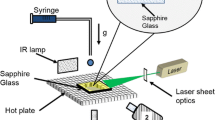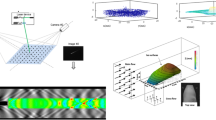Abstract
The impact of a droplet onto a dry or wet surface leads to a rapid formation of a shear flow at the boundary. We present a novel method to experimentally resolve this flow in time at different heights above the solid. The radial flow field close to the substrate is reconstructed by evaluation of streak images of fluorescent tracer particles in the liquid. By using a microscope objective with a narrow depth of field, it is possible to scan through the flow in thin horizontal layers of 5 μm thickness. We focus on the flow close (≤40 μm) to the boundary during the impact of elongated drops with diameters of 0.3–0.4 mm and speeds in the range of 2–3 m s−1. The spatial resolution is obtained from several individual events of the repeatable impact process and varying the focal plane. Fluorescent streaks formed by the suspended particles are recorded with high-speed photography at up to 20,000 frames per second. The impact of water and of ethanol is investigated both on dry glass and on glass covered with a thin film of the same liquid. Results are given as spatio-temporal maps of radial flow velocity at different heights, and the maximum shear stress at the substrate is evaluated. The implications of the results are discussed with respect to cleaning applications.












Similar content being viewed by others
Notes
The parameters chosen lead to reproducible timing and shape of the impacting drops for all four cases (water and ethanol; dry and impact onto a liquid film). Faster drops tended to disintegrate frequently and were less reproducible.
References
Andreas MT, Wostyn K, Wada M, Janssens T, Kenis K, Bearda T, Mertens PW (2009) High velocity aerosol cleaning with organic solvents: particle removal and substrate damage. Solid State Phenom 145–146:39–42
Berberović E, van Hinsberg NP, Jakirlić S, Roisman IV, Tropea C (2009) Drop impact onto a liquid layer of finite thickness: dynamics of the cavity evolution. Phys Rev E 79:036,306
Bouwhuis W, van der Veen RCA, Tran T, Keij DL, Winkels KG, Peters IR, van der Meer D, Sun C, Snoeijer JH, Lohse D (2012) Maximal air bubble entrainment at liquid-drop impact. Phys Rev Lett 109:264,501
Castrejón JR, Betton ES, Kubiak KJ, Wilson MCT, Hutchings IM (2011) The dynamics of the impact and coalescence of droplets on a solid surface. Biomicrofluidics 5(1):014112
Chandra S, Avedisian CT (1991) On the collision of a droplet with a solid surface. Proc R Soc Lond Ser A 432(1884):13–41
Clanet C, Béguin C, Richard D, Quére D (2004) Maximal deformation of an impacting drop. J Fluid Mech 517:199–208
Cossali G, Coghe A, Marengo M (1997) The impact of a single drop on a wetted solid surface. Exp Fluids 22(6):463–472
de Ruiter J, Oh JM, van den Ende D, Mugele F (2012) Dynamics of collapse of air films in drop impact. Phys Rev Lett 108:074,505
Dear JP, Field JE (1988) Highspeed photography of surface geometry effects in liquid/solid impact. J Appl Phys 63(4):1015–1021
Dimotakis PE, Debussy FD, Koochesfahani MM (1981) Particle streak velocity field measurements in a two-dimensional mixing layer. Phys Fluids 24(6):995–999
Driscoll MM, Nagel SR (2011) Ultrafast interference imaging of air in splashing dynamics. Phys Rev Lett 107:154,502
Erkan N, Okamoto K (2014) Full-field spreading velocity measurement inside droplets impinging on a dry solid surface. Exp Fluids 55(11):1845
Frommhold PE, Lippert A, Holsteyns FL, Mettin R (2014) High-speed monodisperse droplet generation by ultrasonically controlled micro-jet breakup. Exp Fluids 55(4):1716
Haller KK, Ventikos Y, Poulikakos D (2002) Computational study of high-speed liquid droplet impact. J Appl Phys 92(5):2821–2828
Haller KK, Poulikakos D, Ventikos Y, Monkewitz P (2003a) Shock wave formation in droplet impact on a rigid surface: lateral liquid motion and multiple wave structure in the contact line region. J Fluid Mech 490:1–14
Haller KK, Ventikos Y, Poulikakos D (2003b) Wave structure in the contact line region during high speed droplet impact on a surface: solution of the riemann problem for the stiffened gas equation of state. J Appl Phys 93(5):3090–3097
Joukowsky N (1900) Über den hydraulischen Stoß in Wasserleitungsröhren. Mémoires de l’Académie Impériale des Sciences de St-Pétersbourg 8(9):1–71
Kanno I, Yokoi N, Sato K (1997) Wafer cleaning by water and gas mixture with high velocity. Electrochem Soc Proc 98:54–61
Kennedy C, Field J (2000) Damage threshold velocities for liquid impact. J Mater Sci 35(21):5331–5339
Lindken R, Rossi M, Große S, Westerweel J (2009) Micro-particle image velocimetry (PIV): recent developments, applications, and guidelines. Lab Chip 9:2551–2567
Mandre S, Mani M, Brenner MP (2009) Precursors to splashing of liquid droplets on a solid surface. Phys Rev Lett 102:134,502
Mani M, Mandre S, Brenner MP (2010) Events before droplet splashing on a solid surface. J Fluid Mech 647:163–185
Mehdizadeh NZ, Chandra S, Mostahhimi J (2004) Formation of fingers around the edges of a drop hitting a metal plate with high velocity. J Fluid Mech 510:353–373
Meinhart CD, Wereley ST, Santiago JG (1999) Piv measurements of a microchannel flow. Exp Fluids 27(5):414–419
Ohl CD, Arora M, Dijkink R, Janve V, Lohse D (2006) Surface cleaning from laser-induced cavitation bubbles. Appl Phys Lett 89:074,102–1–074,102–3
Okorn-Schmidt HF, Holsteyns F, Lippert A, Mui D, Kawaguchi M, Lechner C, Frommhold PE, Nowak T, Reuter F, Piqué MB et al (2014) Particle cleaning technologies to meet advanced semiconductor device process requirements. ECS J Solid State Sci Technol 3(1):N3069–N3080
Pan KL, Tseng KC, Wang CH (2010) Breakup of a droplet at high velocity impacting a solid surface. Exp Fluids 48(1):143–156
Pumphrey HC, Crum LA, Bjørnø L (1989) Underwater sound produced by individual drop impacts and rainfall. J Acoust Soc Am 85(4):1518–1526
Rein M (1993) Phenomena of liquid drop impact on solid and liquid surfaces. Fluid Dyn Res 12(2):61
Rein M, Delplanque JP (2008) The role of air entrainment on the outcome of drop impact on a solid surface. Act Mech 201(1–4):105–118
Rioboo R, Marengo M, Tropea C (2002) Time evolution of liquid drop impact onto solid, dry surfaces. Exp Fluids 33(1):112–124
Roisman IV, Rioboo R, Tropea C (2002) Normal impact of a liquid drop on a dry surface: model for spreading and receding. Proc R Soc Lond A 458(2022):1411–1430
Roisman IV, Berberovic E, Tropea C (2009) Inertia dominated drop collisions. I. on the universal flow in the lamella. Phys Fluids 21:052103-1–052103-10
Smith M, Bertola V (2011) Particle velocimetry inside newtonian and non-newtonian droplets impacting a hydrophobic surface. Exp Fluids 50(5):1385–1391
Srikar R, Gambaryan-Roisman T, Steffes C, Stephan P, Tropea C, Yarin AL (2009) Nanofiber cating of surfaces for intensification of drop or spray impact cooling. Int J Heat Mass Transf 52:5812–5826
Streule W, Lindemann T, Birkle G, Zengerle R, Koltay P (2004) Pipejet: a simple disposable dispenser for the nano- and microliter range. J Assoc Lab Autom 9(5):300–306
Thoraval MJ, Takehara K, Etoh TG, Thoroddsen ST (2013) Drop impact entrapment of bubble rings. J Fluid Mech 724:234–258
Thoroddsen ST, Sakakibara J (1998) Evolution of the fingering pattern of an impacting drop. Phys Fluids 10(6):1359–1374
Thoroddsen ST (2002) The ejecta sheet generated by the impact of a drop. J Fluid Mech 451:373–381
Thoroddsen ST, Thoraval MJ, Takehara K, Etoh TG (2011) Droplet splashing by a slingshot mechanism. Phys Rev Lett 106:034,501
van Dam DB, Clerc CL (2004) Experimental study of the impact of an ink-jet printed droplet on a solid substrate. Phys Fluids 16(9):3403–3414
van der Veen RCA, Tran T, Lohse D, Sun C (2012) Direct measurements of air layer profiles under impacting droplets using high-speed color interferometry. Phys Rev E 85:026,315-1–026,315-6
van Hinsberg NP, Budakli M, Göhler S, Berberović E, Roisman IV, Gambaryan-Roisman T, Tropea C, Stephan P (2010) Dynamics of the cavity and the surface film for impingements of single drops on liquid films of various thicknesses. J Colloid Interface Sci 350(1):336–343
Visser CW, Tagawa Y, Sun C, Lohse D (2012) Microdroplet impact at very high velocity. Soft Matter 8:10,732–10,737
Visser CW, Frommhold PE, Wildeman S, Mettin R, Lohse D, Sun C (2015) Dynamics of high-speed micro-drop impact: numerical simulations and experiments at frame-to-frame times below 100 ns. Soft Matter 11:1708–1722
Watanabe M, Sanada T, Hayashida A, Isago Y (2009) Cleaning technique using high-speed steam-water mixed spray. Solid State Phenom 145–146:43–46
Weiss DA, Yarin AL (1999) Single drop impact onto liquid films: neck distortion, jetting, tiny bubble entrainment, and crown formation. J Fluid Mech 385:229–254
Worthington AM (1908) A study of splashes. Longmans, Green, New York
Xu L, Zhang WW, Nagel SR (2005) Drop splashing on a dry smooth surface. Phys Rev Lett 94:184,505
Xu K, Pichler S, Wostyn K, Cado G, Springer C, Gale GW, Dalmer M, Mertens PW, Bearda T, Gaulhofer E, Podlesnik D (2009) Removal of nano-particles by aerosol spray: effect of droplet size and velocity on cleaning performance. Solid State Phenom 145:31–34
Yarin AL, Weiss DA (1995) Impact of drops on solid surfaces: self-similar capillary waves, and splashing as a new type of kinematic discontinuity. J Fluid Mech 283:141–173
Yarin A (2006) Drop impact dynamics: splashing, spreading, receding, bouncing. Annu Rev Fluid Mech 38:159–192
Acknowledgments
We would like to thank W. Lauterborn for valuable comments regarding the manuscript. The financial support by the Austrian Federal Ministry of Economy, Family and Youth and the Austrian National Foundation for Research, Technology and Development is gratefully acknowledged as is the support from Lam Research AG. Special thanks go to Chan Chon U for inspiring discussions.
Author information
Authors and Affiliations
Corresponding author
Appendix
Appendix
For estimation of the depth of field \(\delta z\) we used equation (4) from Meinhart et al. (1999)
with index of refraction \(n=1\), fluorescence wavelength \(\lambda = 612 \,\hbox {nm}\), numerical aperture \(NA=0.725\), smallest resolvable distance of the image detector \(e = 20 \, \upmu \hbox {m}\), and magnification \(M=20\). This results in a value of 2.4 \(\upmu \hbox {m}\) for the depth of field.
Rights and permissions
About this article
Cite this article
Frommhold, P.E., Mettin, R. & Ohl, CD. Height-resolved velocity measurement of the boundary flow during liquid impact on dry and wetted solid substrates. Exp Fluids 56, 76 (2015). https://doi.org/10.1007/s00348-015-1944-4
Received:
Revised:
Accepted:
Published:
DOI: https://doi.org/10.1007/s00348-015-1944-4




